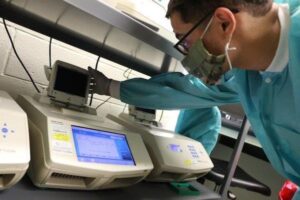
Story by Paul Lagasse
Medical Research and Development Command
FORT DETRICK, Md. – The U.S. Army Medical Research and Development Command is working to commercialize an innovative and cost-effective method of rapidly testing large groups of people for exposure to a broad array of biological threats and infectious diseases at a much lower cost than current testing methods.
The Biodefense Mass Sequencing and Surveillance assay, developed by the Synthetic Biology and Biosurveillance Branch at MRDC’s Institute of Infectious Diseases, combines three widely available laboratory techniques – large-scale sample pooling, polymerase chain reaction testing and next-generation DNA sequencing – in a novel way to rapidly screen samples to identify infected patients and reduce the risk of disease outbreaks.
Sample pooling increases laboratory testing capacity, while PCR testing can identify the presence of a virus’ genetic material even in people who are not showing symptoms. However, by coupling this capability with a retooled next-generation DNA sequencing assay – which uses a genetic barcode system to track patient samples – laboratories will be able to achieve higher testing throughput and lower costs than by using just pooling and PCR testing alone.
Developed at the height of the coronavirus pandemic under the leadership of SBS branch chief Lt. Col. Jeffrey Kugelman, BMASS was designed to address the Army’s need for a fast, brigade-level testing capacity for COVID-19. Thanks to the “all-hands” assistance of personnel from across MRDC and funding from MRDC’s Military Infectious Diseases Research Program and Combat Casualty Care Research Program, within just a few months of being tasked, Kugelman’s team was able to demonstrate that BMASS could successfully screen up to 10,000 samples per instrument per day and see results within 24 to 48 hours.
Because BMASS uses materials and instruments that are readily available in DOD and public health laboratories, its potential is limited only by the capacity of a lab’s PCR testing instruments and available staff.
“Using one of the smaller PCR instruments, you could test half the population of an aircraft carrier every day or an entire battalion in a single go,” says Kugelman. “With a larger instrument, we demonstrated that you could test a hundred thousand samples a day on just one device. You still need people to unpack that many samples and get them loaded into the instrument, but it shows you the potential of this methodology. It’s just unparalleled how many samples you can screen in a day.”
The modular design of BMASS allows it to be used to test for multiple diseases at the same time, extending its potential beyond just COVID-19 surveillance. Kugelman’s team has already developed a test that enables BMASS to screen for two types of influenza, for example.
“In a future outbreak scenario, BMASS can provide commanders with an amazing tool for quickly screening their forces so they can get positive people quarantined and keep the rest in the fight,” says Kugelman.
For their pioneering work on BMASS, Kugelman and his team received a 2021 Invention of the Year Award from MRDC as well as the 2021 Maj. Gen. Harold J. “Harry” Greene Innovation Award in the Acquisition Writing in the Warfighter Team category from Army Futures Command. Kugelman and his team also applied for and received a patent for the methodology.
Having demonstrated both the efficacy and the potential of BMASS, Kugelman is now working with MRDC’s Office of Medical Technology Transfer, which coordinates intellectual property licensing to help DOD inventors successfully commercialize their products for military applications, and MRDC’s Office of Regulated Activities, which guides new FDA-regulated medical products through the agency’s review process to mitigate risk and accelerate their delivery to Service Members.
“I remember like it was yesterday when Lt. Col. Kugelman first called me to talk about the technology,” recalls Dr. Edward Diehl, a commercialization officer with MTT. “I instantly knew that this was an incredible achievement, and that the platform he developed had great value to both military and civilian health care.”
MTT uses an award-winning process it developed called Assistive Technology Transfer, or AT2, which involves working with inventors to systematically mature and de-risk their biomedical technologies to the point that they are ready for licensing by commercial partners. The AT2 process ensures that the first-generation products that reach the Warfighter are mature and military ready.
Diehl says that several companies have expressed interest in working with MRDC to develop BMASS, but agreements have not been finalized and the technology is still available for licensing.
Looking back on the all-hands effort to develop BMASS to help the Army maintain readiness during the pandemic, Kugelman says he is proud of what he and his team accomplished under very trying circumstances and is excited by the BMASS’ prospects for the future.
“The assay can be adapted to pretty much any existing PCR diagnostic target, or we can make our own, and we can spin up very rapidly to provide testing,” says Kugelman. “We’re poised for whatever comes next.”